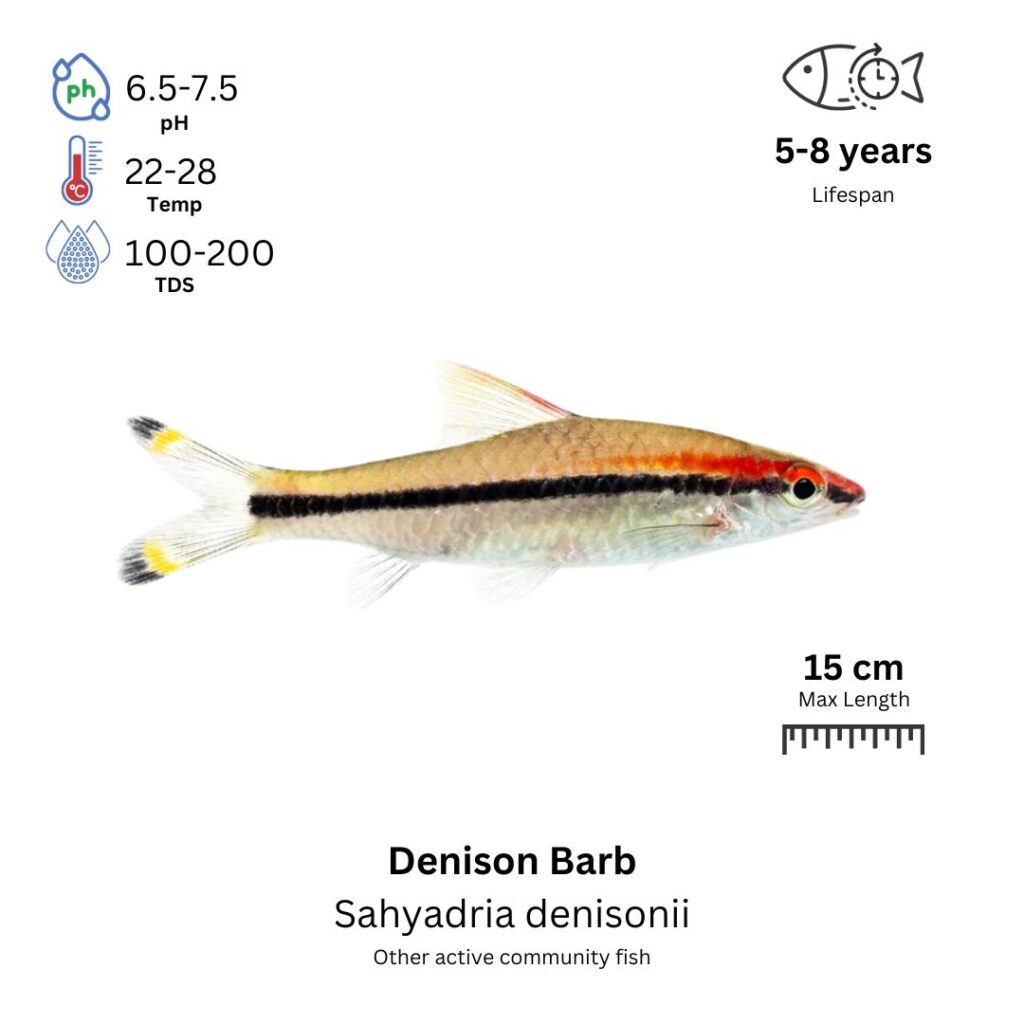Denison Barb
Sahyadria denisonii

Description
The Denison Barb, also known as the Red-Line Torpedo Barb, is a striking, active freshwater fish with an elongated, torpedo-shaped body and vivid coloration. Its body is mostly silver with a bright red horizontal stripe running along each side, from its gill cover to the tail. The fins are often tinted with yellow or orange, adding to its eye-catching appearance. Denison Barbs are peaceful, schooling fish, often seen swimming together in the middle and upper sections of the tank. Their active and social nature makes them ideal for community aquariums, though they do best in larger tanks due to their size and energy.
Habitat Origin
Native to the rivers and streams of the Western Ghats in India, particularly in regions of Kerala and Karnataka. They are found in cool, fast-moving waters with dense vegetation.
Aquarium
Ideal Number in Aquarium: At least 6 individuals, as they are schooling fish and thrive in groups.
Favorite Food

Denison Barbs are omnivores and will eat a variety of foods, including high-quality flake food, pellets, live or frozen foods like brine shrimp, bloodworms, and daphnia. They also enjoy plant matter, such as algae, and may nibble on soft plants in the aquarium.
Behavior:
Denison Barbs are peaceful, active swimmers that are best kept in schools. They are non-aggressive but can be slightly territorial when they feel their space is threatened. They are quite energetic and love to explore their environment, often seen darting around the tank in their schooling groups. While they are generally peaceful, they can become stressed if kept in too small a group or with overly aggressive tankmates. They are best kept with other non-aggressive fish that can keep up with their energetic swimming style.
Special Care:
Denison Barbs require a larger tank with plenty of swimming space, as they are an active species. A well-planted tank with plenty of hiding spots will make them feel more secure. They also appreciate strong filtration and good water movement, as they are used to fast-moving streams in their natural habitat. Regular water changes and stable water conditions are essential for their well-being. These fish are sensitive to water quality and need consistent water parameters to thrive.
Compatibility with Other Fish:
Yes, Denison Barbs are generally compatible with other peaceful species, such as tetras, rasboras, and other barbs. They can also be kept with other small to medium-sized fish that can keep up with their active nature. They should not be kept with overly aggressive or fin-nipping species that might stress them out. Due to their energetic swimming style, it’s important to ensure that tankmates are not overly passive or slow-moving, as Denison Barbs might outcompete them for food.
Breeding Tank Setup
While Denison Barbs can coexist peacefully in community tanks, using a dedicated breeding tank is highly recommended. This setup protects the eggs from being eaten and allows precise control over water parameters. A 20-gallon tank (75 liters) is sufficient for a small breeding group, while a 40-gallon tank (150 liters) is better for larger pairs. Maintain water parameters at pH 6.5–7.5, temperature 24–28°C (75–82°F), and hardness 5–15 dGH. Use a gentle sponge or internal filter to prevent strong currents. Provide a soft sand or fine gravel substrate with Java moss, Hornwort, or Anubias to offer spawning surfaces and fry cover.
Conditioning the Breeders
To condition Denison Barbs for breeding, offer a diverse, high-protein diet including quality flakes or pellets, as well as live or frozen foods like brine shrimp, daphnia, and bloodworms. Supplement their diet with vegetables such as finely chopped spinach or peas. Perform weekly 20–30% water changes to maintain excellent water quality. Prior to breeding, a larger 50% water change and a slight temperature increase to 28°C can mimic the rainy season, which often triggers spawning behavior.
Spawning Behavior
Spawning typically occurs in the early morning or shortly after environmental cues like water changes. Males will become more colorful and actively court females. During spawning, females scatter 50–100 sticky eggs over plants or decorations, which the male fertilizes immediately. Once spawning is complete, remove the adult fish to prevent them from consuming the eggs. The eggs adhere to surfaces and are best left undisturbed in a calm, clean tank environment.
Fry Development & Feeding
Eggs usually hatch within 24–48 hours, depending on temperature. Fry will feed on their yolk sacs for the first few days. Once absorbed, introduce infusoria or liquid fry food, then progress to baby brine shrimp, microworms, or finely crushed flakes as they grow. Maintain high water quality with small daily water changes (10–20%) and stable temperature between 24–28°C (75–82°F). Avoid overfeeding to prevent ammonia buildup, which can be lethal to fry.
Additional Breeding Notes
Denison Barbs reach sexual maturity at around 12–24 months, with better success rates seen in healthy 2-year-old adults. Males are typically slimmer and more vibrantly colored, while females appear rounder, especially when gravid. Avoid stress factors like sudden water changes, overcrowding, or aggressive tank mates. A calm, stable environment with excellent water quality is essential for successful spawning and fry survival.
